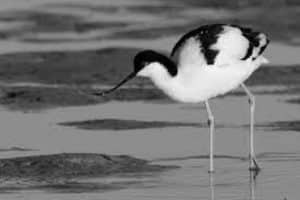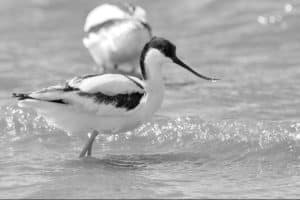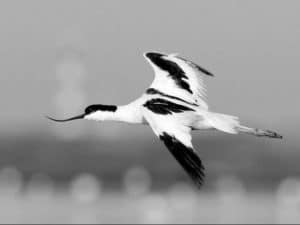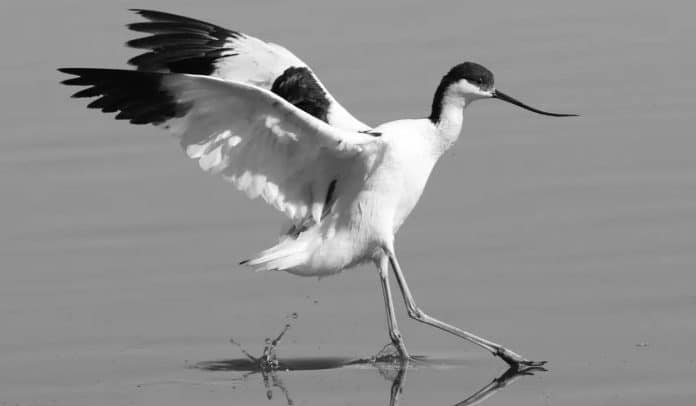Introduction to the Pied Avocet
The Pied Avocet, known scientifically as Recurvirostra avosetta, is a striking bird species found in the wetlands of East Africa, including Tanzania. With its elegant appearance and unique feeding behavior, the Pied Avocet has captivated birdwatchers and nature enthusiasts alike. In this article, we will explore the habitat, distribution, physical characteristics, behavior, breeding, nesting habits, diet, and conservation status of the Pied Avocet in Tanzania. Furthermore, we will discover the best places to spot and photograph these magnificent birds, along with interesting facts about their lives. So, let’s embark on a journey to uncover the secrets of the Pied Avocet in Tanzania.
Habitat and Distribution of the Pied Avocet in Tanzania

The Pied Avocet thrives in a variety of wetland habitats, including salt pans, coastal lagoons, estuaries, and freshwater marshes. In Tanzania, they can be found along the coastal regions, such as the Rufiji Delta and the Saadani National Park, as well as the inland wetlands like Lake Manyara and Lake Natron. These birds are highly adaptable and can tolerate both saline and freshwater environments, making them well-suited to the diverse wetland ecosystems found in Tanzania.
The distribution of the Pied Avocet extends beyond Tanzania, reaching throughout Europe, Asia, and parts of Africa. They are migratory birds, with some populations traveling thousands of kilometers each year. During the breeding season, they can be found in their northernmost range, including countries like the Netherlands, Germany, and Russia. In Tanzania, they are primarily present during the non-breeding season, offering a unique opportunity for visitors to observe and appreciate their beauty.
Physical Characteristics and Behavior of the Pied Avocet
The Pied Avocet is a medium-sized wading bird with distinct black and white plumage. They have long, thin legs and a slender upturned bill, which they use to sweep back and forth in the water to locate prey. Their black wings and back contrast sharply with their white head, neck, and underparts, creating a striking appearance. During flight, their black and white wings flash, adding to their elegance.
These birds are known for their unique feeding behavior. They employ a technique called “scything,” where they sweep their bill side to side in shallow water, stirring up small invertebrates, crustaceans, and insects. The Pied Avocet is highly skilled at detecting prey in murky water, thanks to its sensitive bill. They are also known to feed in groups, creating a synchronized display as they move together in a line, making them a fascinating sight to behold.
In addition to their distinctive feeding behavior, the Pied Avocet is known for its courtship displays. During breeding season, males and females engage in elaborate rituals, including head-bobbing, bowing, and even fencing with their bills. These displays not only serve as a means of courtship but also help establish and defend their territory. The Pied Avocet’s behavior is a testament to the beauty and complexity of nature.
Breeding and Nesting Habits of the Pied Avocet
The breeding season of the Pied Avocet varies depending on the region. In Tanzania, it typically occurs during the dry season, from November to March. During this time, these birds form monogamous pairs and build nests on the ground. The nests are shallow scrapes in the mud or sand, lined with plant material and feathers.
Once the nest is ready, the female Pied Avocet lays three to four eggs, which both parents take turns incubating for about three weeks. The eggs are pale green or olive in color, providing excellent camouflage in the marshy surroundings. After hatching, the chicks are precocial, meaning they can walk and feed themselves shortly after emerging from the egg.
The parents provide constant care and protection to their young, guiding them to suitable feeding areas and defending them against potential predators. The Pied Avocet’s dedication to their offspring is a testament to their nurturing instincts and the importance of family in their lives.
Diet and Feeding Habits of the Pied Avocet

The diet of the Pied Avocet primarily consists of small invertebrates, crustaceans, and insects found in wetland habitats. As mentioned earlier, they employ a unique feeding behavior called “scything” to locate their prey. By sweeping their bill back and forth in shallow water, they disturb the sediment and stir up small organisms, which they then capture with their sensitive bill.
Their bill is not only a tool for feeding but also a highly specialized adaptation. The bill of the Pied Avocet is equipped with nerves that allow them to detect prey hidden in the mud. This remarkable sensory ability enables them to find food even in low visibility conditions, making them highly efficient hunters.
To supplement their diet, the Pied Avocet may also feed on small fish and aquatic vegetation. They are opportunistic feeders, adjusting their diet based on the availability of food sources in their habitat. This adaptability is crucial for their survival, particularly in the ever-changing wetland ecosystems.
Conservation Status and Threats to the Pied Avocet in Tanzania
The Pied Avocet, though not currently listed as globally threatened, faces certain conservation challenges in Tanzania. Wetland loss and degradation due to human activities, such as agriculture, urbanization, and pollution, pose a significant threat to their habitat. These birds rely on healthy wetlands for breeding, nesting, and feeding, making the preservation of these ecosystems crucial for their survival.
Furthermore, the disturbance caused by human activities can disrupt the Pied Avocet’s breeding and nesting behavior, leading to decreased reproductive success. It is essential to raise awareness about the importance of wetland conservation and implement measures to protect these fragile habitats to ensure the long-term survival of the Pied Avocet and other wetland species in Tanzania.
Best Places to Spot and Photograph the Pied Avocet in Tanzania
Tanzania offers several excellent locations for spotting and photographing the Pied Avocet. The Rufiji Delta, located in the Selous Game Reserve, is a prime spot to observe these birds in their natural habitat. The delta’s extensive wetlands provide an ideal breeding ground for the Pied Avocet, attracting a significant number of individuals during the non-breeding season.
Another notable location is the Saadani National Park, situated along the coast of Tanzania. This park offers a unique combination of wetland and savannah habitats, creating a diverse ecosystem that supports a wide range of bird species, including the Pied Avocet. Visitors can explore the park’s wetlands by boat and witness these elegant birds in action.
Lake Manyara National Park is also worth mentioning as it is home to a large population of waterbirds, including the Pied Avocet. The lake’s alkaline waters attract a variety of avian species, making it an ideal destination for birdwatchers and photographers. The best time to visit these locations is during the non-breeding season, from November to March, when the Pied Avocet is most abundant.
Interesting Facts about the Pied Avocet

- The name “avocet” comes from the Italian word “avosetta,” which means “little old woman.” This peculiar name is inspired by the bird’s long, curved bill resembling an old woman’s beak.
- The Pied Avocet is an iconic bird in European folklore and is often associated with good luck. In some cultures, it is believed that seeing an avocet brings blessings and prosperity.
- These birds are excellent fliers and can reach impressive speeds during their migratory journeys. They have been recorded flying at speeds of up to 80 kilometers per hour (50 miles per hour).
- The Pied Avocet has inspired artists throughout history. Its elegant and distinctive appearance has been depicted in various forms of art, including paintings, sculptures, and even stamps.
- Despite their graceful appearance, Pied Avocets are known for their aggression when it comes to defending their territory. They will fiercely defend their nests and young against any potential threats, including larger birds and mammals.
Eco-tourism and the Importance of Preserving Wetlands for the Pied Avocet
Eco-tourism plays a vital role in the conservation of the Pied Avocet and its habitat in Tanzania. By promoting responsible tourism practices, visitors can contribute to the preservation of wetlands and the protection of the avian species that depend on them. Supporting local initiatives and organizations that focus on wetland conservation is another way to make a positive impact.
Preserving wetlands not only benefits the Pied Avocet but also helps maintain the overall ecological balance of these fragile ecosystems. Wetlands act as natural filters, purifying water and providing essential habitats for countless other species. By safeguarding wetlands, we ensure the continued survival of these invaluable ecosystems and the biodiversity they support.
Conclusion
The Pied Avocet is a fascinating bird species that adds beauty and grace to Tanzania’s wetlands. With its striking black and white plumage, unique feeding behavior, and elegant courtship displays, it is no wonder that these birds captivate the hearts of birdwatchers and nature enthusiasts. However, the Pied Avocet faces challenges in the form of habitat loss and disturbance, emphasizing the importance of wetland conservation.
By raising awareness, supporting local initiatives, and practicing responsible tourism, we can contribute to the preservation of the Pied Avocet and its wetland habitats in Tanzania. Let us appreciate the beauty of these elegant wetland dwellers and strive to protect the precious ecosystems they call home. Together, we can ensure a future where the Pied Avocet continues to grace the wetlands of East Africa with its presence.


































